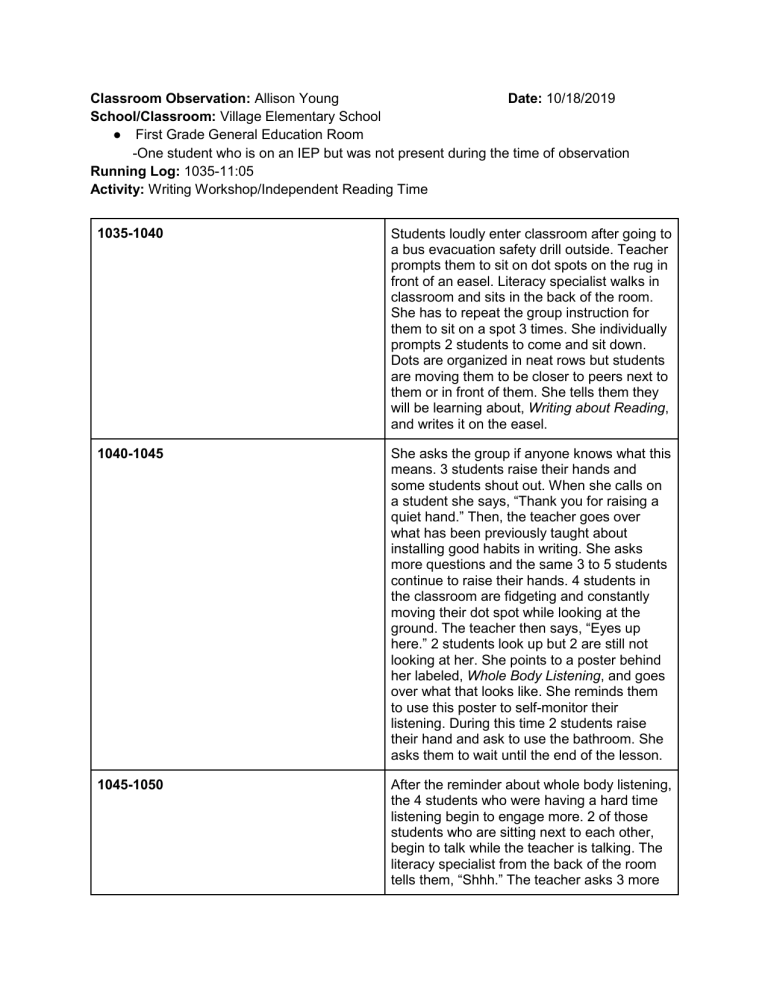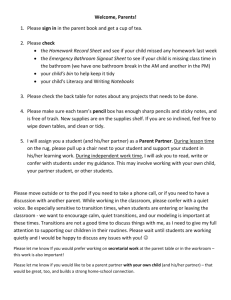
Classroom Observation: Allison Young Date: 10/18/2019 School/Classroom: Village Elementary School ● First Grade General Education Room -One student who is on an IEP but was not present during the time of observation Running Log: 1035-11:05 Activity: Writing Workshop/Independent Reading Time 1035-1040 Students loudly enter classroom after going to a bus evacuation safety drill outside. Teacher prompts them to sit on dot spots on the rug in front of an easel. Literacy specialist walks in classroom and sits in the back of the room. She has to repeat the group instruction for them to sit on a spot 3 times. She individually prompts 2 students to come and sit down. Dots are organized in neat rows but students are moving them to be closer to peers next to them or in front of them. She tells them they will be learning about, Writing about Reading, and writes it on the easel. 1040-1045 She asks the group if anyone knows what this means. 3 students raise their hands and some students shout out. When she calls on a student she says, “Thank you for raising a quiet hand.” Then, the teacher goes over what has been previously taught about installing good habits in writing. She asks more questions and the same 3 to 5 students continue to raise their hands. 4 students in the classroom are fidgeting and constantly moving their dot spot while looking at the ground. The teacher then says, “Eyes up here.” 2 students look up but 2 are still not looking at her. She points to a poster behind her labeled, Whole Body Listening, and goes over what that looks like. She reminds them to use this poster to self-monitor their listening. During this time 2 students raise their hand and ask to use the bathroom. She asks them to wait until the end of the lesson. 1045-1050 After the reminder about whole body listening, the 4 students who were having a hard time listening begin to engage more. 2 of those students who are sitting next to each other, begin to talk while the teacher is talking. The literacy specialist from the back of the room tells them, “Shhh.” The teacher asks 3 more questions about a book they read together as a class 2 days before the lesson, and the same 3 to 5 students are raising their hands every time. She says, “I’m going to challenge you if you haven’t put your hand up.” The teacher works with the class to come up with an answer to the question, Why did we like this book?, and asks them to share things they found funny about the story. They all raise their hand . 1050-1055 After the group response is written, she tells them this is something they will be practicing more on Monday, and shows them the journals they will be writing in. Students begin to fidget again, and the verbal prompt, “Eyes on me,” is given. She then discusses how it is time to start readers workshop, and reminds them that they are working towards a goal of 24 minutes of independent reading time. She dismisses them in groups of 3 to go get their reading bags, and sit in their designated reading spot. She allows the students who needed to go to the bathroom to go, and then 2 more ask to use it. She sits at her desk and calls 2 students over for small group instruction with her. The literacy specialist sits with one student and quietly reads with them. 1055-11 Students begin to quietly read out loud or to themselves around the room. Some students begin to engage in conversation and the teacher calls from her desk to stop talking. One student begins to chat more with another student loudly and she calls him over. She asks him to go over and look at the expected behaviors for independent reading poster as a reminder for how he should be acting. Students are coming in from the bathroom and others become distracted by this and begin to talk to them. One student comes back from the bathroom and sits with his reading bag but does not open a book. A lot of the conversations between students heard were about the books they were reading but appeared to be distracting to other students. The literacy specialist moves to another student who has been on task the whole time. During this time a student has been using the ASL sign for bathroom with no teacher responding to this. She sits there not reading with this gesture waiting for a teacher to notice her. 11-11:05 Students continue to chat about books occasionally but independently return to task. The teacher calls up 2 different students to her small group instruction. The literacy specialist goes to the student who returned from the bathroom and was not on task to read with. Another student raises their hand with the ASL symbol but no teachers notices him. Time Sampling Recording: On Task Behavior (Momentary Time Sample) ● An “x” was marked when the target behavior was observed at the end of the time interval. ● I begin this time sample at 10:55 when students begin their independent quiet reading time and ended it at 11:20 when this activity was wrapping up. Time: 105511 11-1105 11051110 11101115 Student 1 x x^ x^ x Student 2 x x^ x^ x Student 3 x x x x Student 4 * Student 5 x * x x^ Student 6 x x x x Student 7 x x x x^ Student 8 x x x x Student 9 x x x x x 80% Student 10 x x x x x 100% Student 11 x x x Student 12 * x x* 1115-1120 % 80% x 100% 80% x* 20% x^ 80% 80% x^ 100% 80% 60% x 60% Average: 76.67% *: Student in restroom X^: Attending while in small group instruction X*: Attending while sitting with literacy specialist : Strong Points: ● The teacher chose books that all the students were interested in ● Background knowledge was activated by reviewing previously learned skills ● The classroom is well organized and student book bags were in an easily accessible place ● The teacher had positive in interactions with students. She was always smiling and appeared interested in what students were sharing with her. ● The teacher had a light-up sign at her desk that said, “Small group in session.” This visual allowed students to know she was unavailable during independent reading time. ● Students were all having positive interactions with each other and enjoyed sharing points about their books. ● Students felt comfortable reading out loud and were all reading at an appropriate volume ● Positive praise was frequently given when room was quiet and students were following expectations ● Students were staying in their designated reading areas ● Teacher was patient when students were talking and listened to all questions and comments Suggested Recommendations: ● If a transition was loud or challenging do a calming activity, like square breathing, to help students be calm and ready to learn ● Go as a group to the bathroom before the lesson allowing students the opportunity, then they don’t have to interrupt a lesson, or miss out on instructions. ● Have a bathroom pass, perhaps seperate ones for the boys and girls bathroom, available in the classroom. Students can independently take it when they need to. Also, a sign could be put down on the student’s desk when they leave, making it so the instructor can know who has left the room. ● Have dots on floors that aren’t as easily moved or consider other options for designated seating on rug. ● Pre-teach expectations before writer’s workshop. Go over whole-body listening and what it looks like. By using both the poster and having students model it. ● Pre-teach expectations during independent reading time. Read over poster on classroom expectations while reading together. ● ● ● ● ● A lot of the posters on the wall had rules written in words. Add pictures to these expected behaviors that can act as visuals to students who aren’t sure what the poster says. The literacy specialist should sit with the group, rather than the back of the room, during the writing lesson and prompt students to listen while the teacher is talking. The literacy specialist in between changing students should monitor for on-task behavior. Some of the students may not have the stamina for the 24 minutes of independent time and could be given other quiet tasks to work on while sitting. Have a share-out opportunity where students can chat with each other about what they’re reading when it isn’t during the designated independent reading time.
